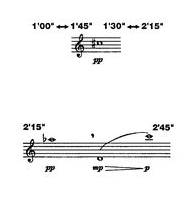| Title | Instrumentation | Date of composition | Dedicatee(s) | Details |
|---|
| Twenty-Three | upper strings (13-5-5-0) | 1988, before June 21 | Commissioned by the Yellow Barn Music Festival | Each performer has their own chronometer, and decides when to start. |
| Twenty-Six | 26 violins | December 1991 | Rundfunk-Sinfonieorchester Saarbrücken and the Alte Oper | This piece may be performed with Twenty-Eight (Fifty-Four), Twenty-Nine (Fifty-Five), or both (Eighty-Three). All time brackets contain a single sound. The first violin starts the videoclock. |
| Twenty-Eight | 3 flutes, 1 alto flute, 4 clarinets, 3 oboes, 1 English horn, 3 bassoons, 1 contrabassoon, 4 trumpets, 4 horns, 2 trombones, 1 bass trombone, 1 tuba | December 1991 | Rundfunk-Sinfonieorchester Saarbrücken and the Alte Oper | This piece may be performed with Twenty-Six (Fifty-Four), Twenty-Nine (Fifty-Seven), or both (Eighty-Three). All time brackets contain a single sound. The first flute starts the videoclock. |
| Twenty-Nine | 2 timpani, 2 percussionists, bowed piano, lower strings (0-10-8-6) | December 1991 | Rundfunk-Sinfonieorchester Saarbrücken and the Alte Oper | This piece may be performed with Twenty-Six (Fifty-Five), Twenty-Eight (Fifty-Seven), or both (Eighty-Three). All time brackets contain a single sound. The first viola starts the videoclock. |
| Fifty-Eight | 3 piccolos, 4 flutes, 3 alto flutes, 4 oboes, 3 English horns, 4 B-flat clarinets, 3 bass clarinets, 4 bassoons, 3 contrabassoons, 3 soprano saxophones, 3 alto saxophones, 3 tenor saxophones, 3 baritone saxophones, 4 horns, 4 trumpets, 4 tenor trombones and 3 tubas | March 1992 | Solf Schaefer and the Österreichische Rundfunk (Pannonisches Blasorchester) | This large work (some 60–70 time brackets per part) was composed to be performed at The Landhaus in Graz, a 16th-century Renaissance building. The Landhaus has 58 arches, in which the performers were to be positioned. |
| Sixty-Eight | 3 alto flutes, 3 Cor Anglais, 5 clarinets, 5 trumpets, 4 percussionists, 2 pianos, strings (14-12-10-10-0) | February 1992 | Ernstalbrecht Stiebler and the Sinfonieorchester des Hessischer Rundfunks | Each part has 15 time brackets, each with a single sound. The sequence of pitches is always the same, but time bracket durations are different. |
| Seventy-Four | 3333–4331, 2 pianos, 2 percussionists, harp and strings (14-10-8-8-6) | March 1992 | Francis Thorne, Dennis Russell Davies and the American Composers Orchestra | There are just two parts: one for high instruments, another for low. Performance notes suggest slight exaggeration of the usual imperfection of tuning, to give the impression of a microtonal work. |
| Eighty | 7 alto flutes, 7 English horns, 7 clarinets, 7 trumpets, upper strings (16-14-12-10-0) | February 1992 | András Wilheim | All parts are identical, only transposed for each instrument. Premiered on 28 October 2011 at Munich's Herkulessaal, with the Symphonieorchester des Bayerischen Rundfunks conducted by David Robertson. |
| 1O1 | 4 (picc, alto) 4 (2 cor anglais) 4 (bass clarinet) 4 (contrabassoon) – 6431, timpani, 4 percussionists, piano, harp, strings (18-16-11-11-8) | 1988, before November 13 | Boston Symphony Orchestra | The title is to be spelled with capital "O" (unlike 103 and 108). The instrumentation includes bullroarers and angklungs. Although the piece is scored for a large orchestra, the duration is approximately 12 minutes, and the maximum number of time brackets per part is 12. |
| 103 | 4 (+picc, +alto) 4 (+2 cor anglais) 4 (+bass clarinet) 4 (+contrabassoon) – 4441, 2 timpani, 2 percussion and strings | September 1991 | Henning Lohner, Wolfgang Becker-Carsten and the Kölner Rundfunk-Sinfonieorchester | All parts consist of series of single tones. The piece may be performed together with One11 (which is an abstract film). |
| 108 | 4 (+piccolo, +alto flute), 5 (+2 English horns), 5 (+2 Bass clarinets), 5 (+2 Contrabassoons) – 7551, 5 percussionists and strings (18-16-12-12-8) | April 1991 | Symphonie-Orchester des Süddeutschen Rundfunks | Similar in structure to a symphony, the work is in four movements (A, B, C, D) with silence occurring at the start, between each movement, and at the end. The percussion instruments are "distinguished from one another but not named" and should be "very resonant." The piece may also be performed as a cello concerto with One8 (109a), as a shō concerto with any three movements of One9 (109b), and as a double concerto for shō and five conch shells with any three movements of Two3 (110). The first performance of One8 and 108 (109a) was performed by the Stuttgart Radio Symphony Orchestra, November 30, 1991 with Michael Bach, cello soloist with curved bow. |
